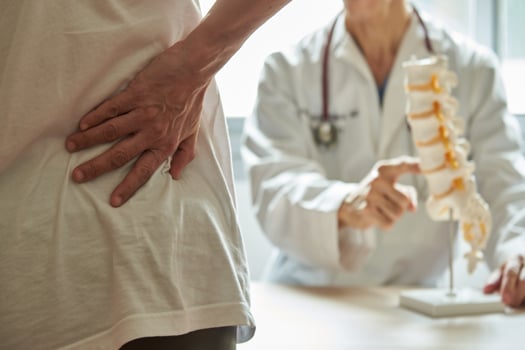
A herniated disc is a common spinal condition that occurs when one of the discs that cushion the vertebrae (bones) of the spine bulges or ruptures and presses on a nearby nerve root. This can cause pain, numbness, tingling, or weakness in the back, neck, arm, or leg, depending on where the herniated disc is located.
There are different types of herniated discs, and some are more severe than others. This article will discuss the most severe form of herniated disc and how to identify its symptoms so you will know when to seek prompt medical attention.
Sequestered Disc
The most severe form of herniated disc is known as a "sequestered disc." This type of herniation occurs when the disc's inner material breaks free and moves into the spinal canal, putting pressure on the spinal cord or nerves. A sequestered disc is the most severe form of herniated disc because it can cause significant and often permanent nerve damage if not treated promptly.
Symptoms of a Sequestered Disc
The symptoms of a sequestered disc are similar to those of other herniated discs, but they are often more severe. Common symptoms include:
- Intense pain in the affected area
- Numbness or tingling in the arms or legs
- Muscle weakness
- Difficulty moving or walking
- Loss of bladder or bowel control
If you experience any of these symptoms, seek medical attention immediately. A sequestered disc requires prompt treatment to prevent permanent nerve damage.
Diagnosing a Sequestered Disc
Diagnosing a sequestered disc typically involves a physical exam and imaging tests. Your doctor will likely ask you about your symptoms and medical history and perform a physical exam to check for muscle weakness, reflexes, and sensation. Imaging tests, such as X-rays, CT scans, and MRI scans, can help your doctor identify the location and severity of the herniated disc.
Treating a Sequestered Disc
The treatment for a sequestered disc typically involves a combination of rest, medication, and physical therapy. In severe cases, surgery may be necessary.
- Rest – Resting can reduce inflammation and pain. Your doctor may recommend bed rest or limiting certain activities.
- Medication – Over-the-counter pain medications, such as ibuprofen and acetaminophen, can relieve pain and reduce inflammation. If necessary, your doctor may prescribe stronger medications, such as muscle relaxants or opioids.
- Physical therapy – Physical therapy can strengthen the muscles around the affected area, increase flexibility, and reduce pain.
- Surgery – If conservative treatments have been unsuccessful, surgery may be recommended. Herniated disc surgery, typically in the form of a discectomy or less invasive microdiscectomy, involves removing the herniated disc material to relieve pressure on the spinal cord or nerves.
Preventing Herniated Discs
While herniated discs cannot always be prevented, there are several steps you can take to reduce your risk. These include:
- Maintaining a healthy weight
- Practicing good posture
- Exercising regularly
- Lifting heavy objects correctly
- Avoiding repetitive motions that can strain your back
A herniated disc can be a painful and debilitating condition that significantly affects your quality of life. However, with proper diagnosis and treatment, you can manage your symptoms and prevent further complications. If you have any symptoms of a herniated disc, consult your doctor as soon as possible for an evaluation and treatment plan.
If you have a herniated disc that is not responding to conservative treatment, a discectomy or microdiscectomy may be discussed and potentially recommended. Although this is generally a very successful procedure, having a large hole in the outer ring of the disc more than doubles the risk of needing another operation. A new treatment, Barricaid, is a bone-anchored device that closes this hole, and 95 percent of Barricaid patients did not undergo a reoperation due to reherniation in the 2-year study timeframe. This treatment is done immediately following the discectomy—during the same operation—and does not require any additional incisions or time in the hospital.
If you have any questions about the Barricaid treatment, ask your doctor or contact us at 844-288-7474.
For full benefit/risk information, please visit: https://www.barricaid.com/instructions.


Comments